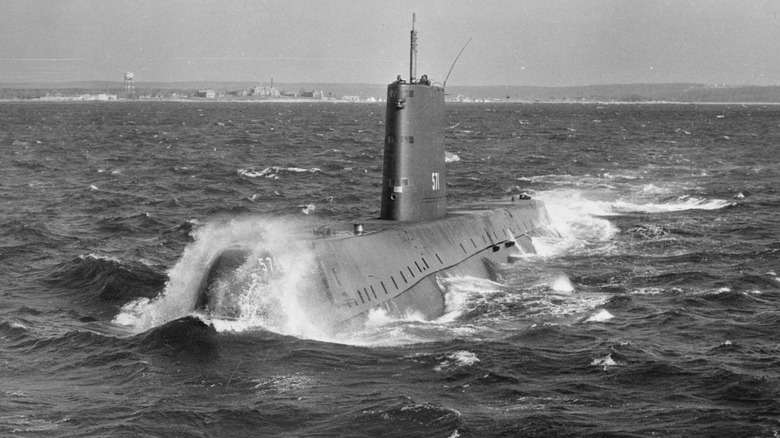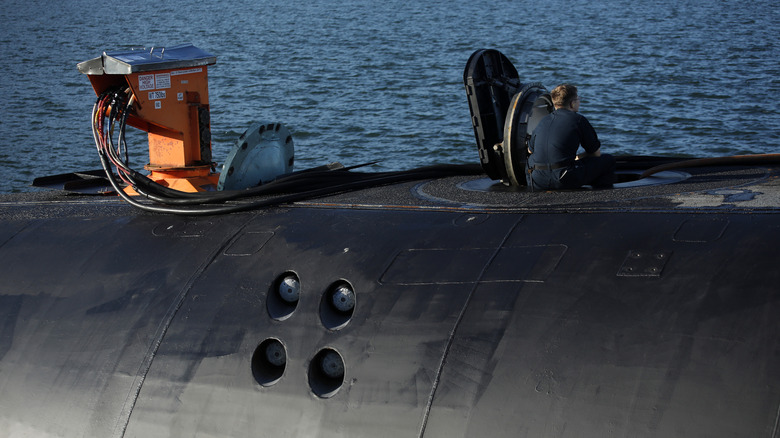How Long Could Military Submarines Stay Underwater Then Versus Now?
Submarines were dreamed of long before humanity had the technology to create the nuclear-powered war machines we know today. As long ago as the 16th century, British naval officer William Bourne dreamed up a design for an enclosed boat that could be rowed underwater. In 1620, Dutch inventor Cornelis Drebbel built a working submersible similar to Bourne's idea, which he took under the Thames River to depths of 12 to 15 feet several times over the course of four years.
While it would be nice to think that the goal for submarines was to learn about underwater wildlife and habitats, over time, the main drivers of the technology had another purpose in mind: defeating enemies. America's first attempts at sabotaging a foe on the water came in 1775, during the Revolutionary War, in a submersible contraption called the Turtle. As the name suggests, the world's first combat sub was shaped like two turtle shells joined together. It could only carry one person and submerge to a depth of 6 feet for a maximum of 30 minutes. The Turtle's mission was to sneak up on British naval ships and stick explosives into their hulls. While the vessel failed two attempts at attaching the explosives, it still proved a stealthy way to get close to enemies and potentially take them out.
There were several more attempts, fits, and starts before submarines could stay underwater for long stretches without coming up for air, potentially alerting adversaries to their location. Today, with all of the U.S. Navy's subs being nuclear-powered, they can stay submerged for months at a time. As of this writing, the record is 140 days.
The evolution of military submarines
The first official U.S. naval submarine was the H.L. Hunley. During the Civil War, it was the first sub to successfully take out a warship when it sank a Union blockade vessel in 1864. That attack, however, also backfired, and the H.L. Hunley went missing for 131 years. It's still unclear what happened to the sub and its eight-man crew. At the time of its disappearance, it could only hold breathable air for two hours before either needing to surface, which meant a risk of being seen, or using an air recirculation system in order to not have to surface. It's still unclear why the Hunley never surfaced, but one theory is that the crew ran out of oxygen.
Over the next century, the U.S. Navy continued improving the capabilities of its submarines, but what really changed the game as far as submersion length was when nuclear energy started powering the vessels instead of diesel fuel. In 1954, the first nuclear-powered submarine, the USS Nautilus, came onto the scene. Two experimental missions took place in 1959 in which two subs stayed submerged for 30 days each, the longest humans had ever lived in an artificial atmosphere at that point.
Submarine experts Giunio G. Santi and Francesco Popia explained why nuclear energy made such an impact in the U.S. Naval Institute: "[N]uclear energy is practically inexhaustible, while, for the diesel-powered boat, energy is limited. This, together with the need to approach the surface periodically to let the engine breathe, makes diesel-powered submarines much more vulnerable to detection. The nuclear-powered submarine's limit lies in the endurance of her crew, while the limit of the conventional diesel boat is its underwater range before needing to surface."
Subs can stay submerged much longer than their crews
Technology seems to have surpassed the limit of what people can reasonably be expected to do. Wired reports that a nuclear-powered sub could potentially stay underwater for up to 25 years, but that would be akin to a prison sentence or a cruel reality show. Why would anyone want to serve on a submarine for that long without ever seeing daylight or loved ones? Realistically, while subs themselves can stay submerged and running well for years, the longest mission conducted by the U.S. Navy so far was 140 days, and that was back in 2014.
Britain, our old Revolutionary War adversaries who we tried and failed to attack via the Turtle, has outdone the U.S. on submersion length. In 2024, their sub called HMS Vengeance stayed (mostly) underwater for 201 days — think six months of the same people every day, no fresh air or windows, and outside contact limited to 40 words per week in "family grams," per The National Interest. That's far more of a lockdown than anyone saw during the height of COVID-19, and it stands to reason that mental health has to be taken into account for the crew who work in the "Silent Service."
In the U.S., submarine missions tend to last a maximum of about four months at depths of more than 600 feet. A far cry from the first official Navy sub that could only withstand being underwater for two hours.


